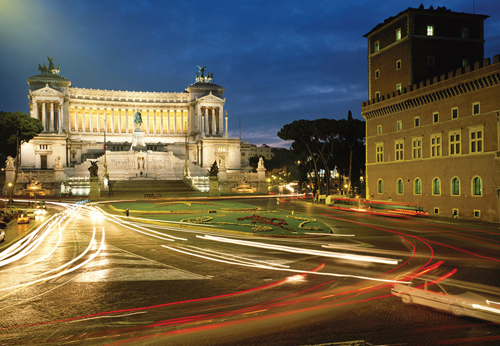Squares and Fountains

Piazza Navona
The elongated oval of Rome’s loveliest square hints that it is built atop Domitian’s ancient stadium. This pedestrian paradise is filled with cafés, street performers and artists, milling tourists, kids playing football, and splashing fountains. Bernini designed the central Fountain of Four Rivers, and added the Moor figure to the most southerly of the piazza’s other two fountains, constantly altered from the 16th to 19th centuries (see Piazza Navona).

Trevi Fountain
Tradition holds that if you throw coins into this 1732 Nicola Salvi fountain, you ensure a return to Rome. Ingeniously grafted on to the back of a palazzo (even the windowsills mutate into rough rocks), the Trevi marks the end of the Acqua Vergine aqueduct, built by Agrippa in 19 BC from a spring miraculously discovered by a virgin (see Trevi Fountain).
Trevi Fountain
Campo de’ Fiori
This “field of flowers” bursts with colour during the morning market, and again after dark when its pubs and bars make it a centre of Roman nightlife. The dour hooded statue overlooking all is in honour of Giordano Bruno, a theologian who was burned at the stake here for his progressive heresies in 1600 during the Counter-Reformation (see Campo de’ Fiori).

Piazza del Popolo
Architect Giuseppe Valadier expanded this site of festivals and public executions into an elegant piazza in 1811–23, adding four Egyptian-style lion fountains to the base of one of Rome’s oldest obelisks. The 1200 BC Ramases II monolith was moved to the Circus Maximus by Augustus then placed here by Pope Sixtus V (see Piazza del Popolo).
Piazza del Popolo
Piazza San Pietro
Bernini’s gargantuan colonnade, 196 m (640 ft) across, embraces the hordes of worshippers and tourists arriving at St Peter’s. Its perfect ellipse is confirmed by the optical illusion of disappearing columns afforded by standing at one of the focus points – marble discs set between the central 1st-century BC obelisk, carved in Egypt for a Roman Prefect, and either fountain: Bernini’s on the left, Domenico Fontana’s on the right (see Piazza San Pietro).
Piazza San Pietro
Fontana delle Tartarughe
Giacomo della Porta designed this delightful fountain between 1581 and 1584. The turtles (tartarughe) struggling up over the lip, however, were added in 1658, perhaps by Bernini (see Fontana delle Tartarughe).
Fontana delle Tartarughe
Piazza Barberini
This busy piazza is centred on Bernini’s Triton Fountain (1642–3), the merman spouting water from a conch shell. It was commissioned by Pope Urban VIII and features his family symbol (bees) on its base (see Piazza Barberini).

Piazza Venezia
The de facto centre of Rome and convergence of traffic patterns, during evening rush hour conducted with balletic brio by a white-gloved policeman. The piazza is flanked by the Palazzo Venezia, from whose balcony Mussolini once exhorted hordes to the joys of Fascism (see Piazza Venezia).

Fountain of the Naiads
The water spouting from Bernini’s Triton is puny compared to the gushes rising from Glaucus in this huge fountain and traffic circle. The fountain is surrounded by naiads and horses in this 1888 confection by Mario Rutelli (grandfather of Francesco, the city’s mayor from 1993 to 2001).
Piazza della Republica
Piazza Santa Maria in Trastevere
A perfect neighbourhood square: cafés, shops, a fine restaurant, and a 17th-century palazzo abutting a medieval church, its mosaics romantically floodlit at night. A fountain fitted with shells by Carlo Fontana (1682) atop a pedestal of stairs serves as benches for backpackers to strum guitars and tourists to eat ice cream (see Santa Maria in Trastevere).

